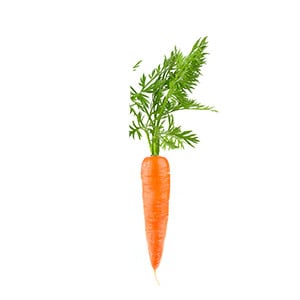Carrots

Carrots
Daucus carota ssp. sativus
Plant family
Umbellifers (Apiaceae)
Cultivation Break
4 Years
Season Overview
Sowing
Harvest
J
F
M
A
M
J
J
A
S
O
N
D
Details
Light requirement
Sunny
Water requirement
Moist
Soil
Light (sandy)
Nutrient requirement
Medium
Light germinator
Germination temperature
8 - 25 °C (Degrees Celsius)
Plant distance
3 cm
Row spacing
30 cm
Seeding depth
0.5 cm
Instructions
The season for this plant is over. The following instructions are for the next season.
Mid of March
Sowing
Mid of March
Weeding
Every week
Beginning of April
Pest protection
Description
A classic among the root vegetables: the carrot. The taproot is the storage organ of the plant and varies in shape and color (yellow, orange to purple) depending on the variety. In the second year, the carrot shoots and forms an inflorescence. Then the root withers and is no longer edible.
Origin:
North Africa, Europe and Western Asia
Growing tips
Carrots prefer deep, loose soil with a high humus content and good nutrient supply. Sowing of early and summer carrots should be done as early as possible from mid-February, as germination takes up to 45 days at 5°C. The seedlings grow very slowly and need a lot of attention in the beginning so that they are not overgrown by weeds. It is a good idea to sow one row of radishes next to each row of carrots as a marker seed. After germination, the seedlings should be thinned out.
Companion Plants
Arugula / Rocket
Broccoli
Brussels sprouts
Cabbage (Cabbage)
Cabbage (Savoy cabbage)
Cauliflower
Chard
Chili
Chives
Collard greens (Kale)
Collard greens (Tuscan kale / Dinosaur kale / Palm tree kale)
Common marigold
Cress
Dill
Garlic
Kohlrabi / German turnip / Turnip cabbage
Leeks
Lettuce (Endive / Escarole / Erisée)
Lettuce (Lettuce)
Napa cabbage / Chinese cabbage
Onion
Onion (Spring onion)
Oregano
Pak Choi
Pea
Pepper / Paprika
Radish
Radishes
Rosemary
Sage
Thyme
Antagonistic Plants
Diseases
Blight of carrot
Pests
Root knot nematodes
Carrot fly